In early October I had the opportunity to take Lincoln cathedral’s ‘Guided Rooftop Tour.’ Due to COVID restrictions, there was only a 3-week window when the tours were reopened before unfortunately the national guidance changed and the tours ceased. If, like me, you are fascinated with the history and architecture of cathedrals, then I strongly recommend signing up for one of these tours when they reopen. You get a full 90 minutes of behind the scenes access. Pictures are allowed to be taken on the tour, so I thought I would share some of my journey with those who might have interest.
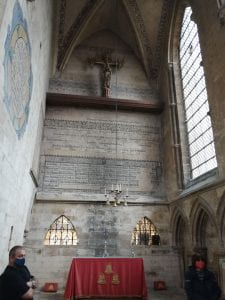
The tour began in the southwest chapel (Ringers’ Chapel), dedicated to the cathedral’s bell ringers where the names of the lead ringers are written on the walls above the altar. Thirteenth-century equilateral arcading and a colourfully decorated vaulted ceiling make even this first stop an enjoyable one.
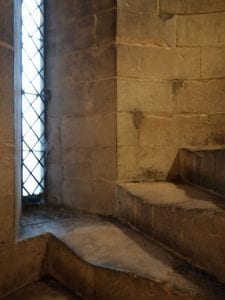
My apologies for the poor quality of this image (above), but I wanted to show how narrow and tight the steps can be. This section of the cathedral retains much of its Norman feel, and the stairwells are similar to those in the White Tower in London. They go in a tight circle, so sturdy footwear and care in walking are a must.
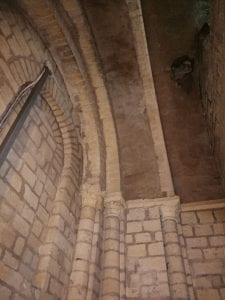
Above the southwest chapel are some excellent examples of Norman architecture, such as these semi-circular arches. These would have been on the ‘outside’ of the southwestern tower facing south prior to expansion. Unlike the western front of the cathedral, these stones have been removed from the outdoor elements since the mid-thirteenth century and have not discoloured.
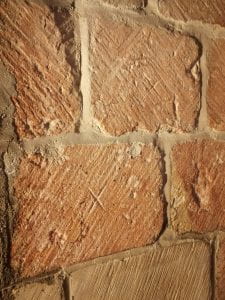
On the next floor up there are some excellent remnants of the cathedral’s challenging past. These stones along the stairwell have turned red from the exposure to fire, possibly the one in 1141 that coincided with King Stephen’s siege of the castle, according to Jonathan Foyle. The ‘X’ marks were from masons inspecting the integrity of the stone, where those that were comprised by the heat of the fire were removed and replaced, as you can see in the two at the bottom of this image (above).
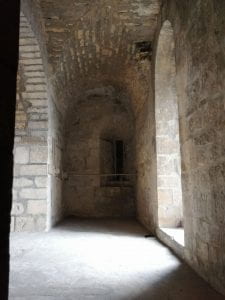
The eleventh-century architecture is evident everywhere as you make your way up the western front of the cathedral, including here in the corner of the tower with a brightly lit western window and a closed off southern facing one. The metal bar is one of many that help ensure the stabilisation of the oldest part of the building. Earthquakes have been a historical problem for the cathedral, and these measures are intended to provide the building with an ability to ‘wobble’ slightly to prevent damage in the case of another earthquake.
The room that sits above the main western entrance is just below the roof between the two towers. Visitors can see a large model of the cathedral encased here that gives an excellent representation of the cathedral from 1311 to 1548, where the spire of its central tower made it the tallest building in the world at 160m.
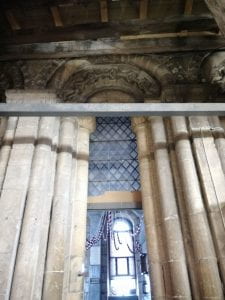
The room between the two towers also contains evidence of Norman architecture, long hidden from the public and the elements outdoors since expansion. This side faces inwards towards the other tower. It received the same level of detail as the western facing ones the public can see today from the ground. Through the window (turned door) you can see the bell ringers’ room with the cords descending from the ceiling. Due to the weight and counter-pull from the bells, ringing requires training and careful execution as it can be a dangerous task!
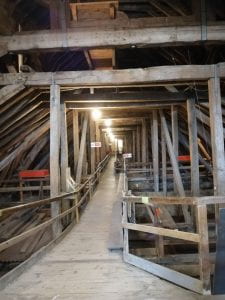
This (above) is the roof between the towers that runs from the western front of the building back to the central tower. Our guide said that, while they replace wood that shows significant wear or strain, many of these beams are over 700 years old and most were made from the strong oaks in Sherwood Forest.
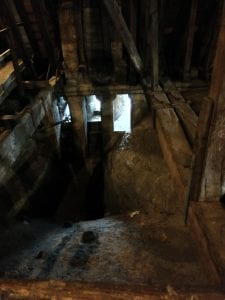
Here (above) you can see the vaulted ceiling and window bays of the nave below.

The tour also takes you outside to see both the southern and western views from atop the cathedral. The view from the western rooftop (above) provides a picturesque look at Lincoln castle. It is plausible that King Stephen himself came up here to assess the progress of his siege in 1141 (and perhaps even to see his cousin, Robert of Gloucester, arriving with an army to attack him from the plains beyond the castle).
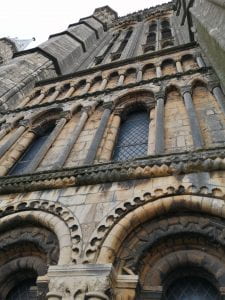
The western rooftop provides an opportunity to see the detail of the Norman stonework that cannot be appreciated from the ground level below with the naked eye. Here (above) the stark contrast between different time periods of the tower’s ride upwards can be seen, with differences of stone use and architecture just above the higher row of arcading.
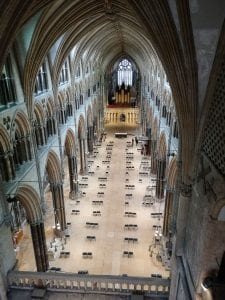
There is a breath-taking view of the nave as the tour heads down from the rooftops and crosses between the towers. Walking along the triforium provides some beautiful views of the nave below, but attention must be given to the beams that often cross the walkway. Since I am vertically challenged, this was easier for me to navigate, but taller individuals should pay extra care on this part of the tour.
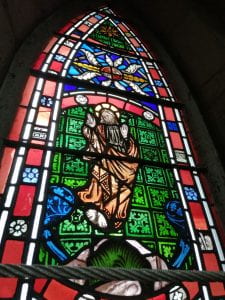
The tour also provides an opportunity to see some beautiful stained glass in the north transept that cannot be seen by the public below (above). The tour then concludes after winding its way down the steps in the corner of the transept. I took plenty of more pictures but tried to limit what I have shared here to provide an overview of what a guest would see on this tour. When the tours open up again, I will be first in line for another opportunity to take it all in for a second time. I firmly believe this is the best value of anything I have experienced here in the UK, and I am sure that any historian or architecture enthusiast would find this tour an invaluable part of the Lincoln experience.